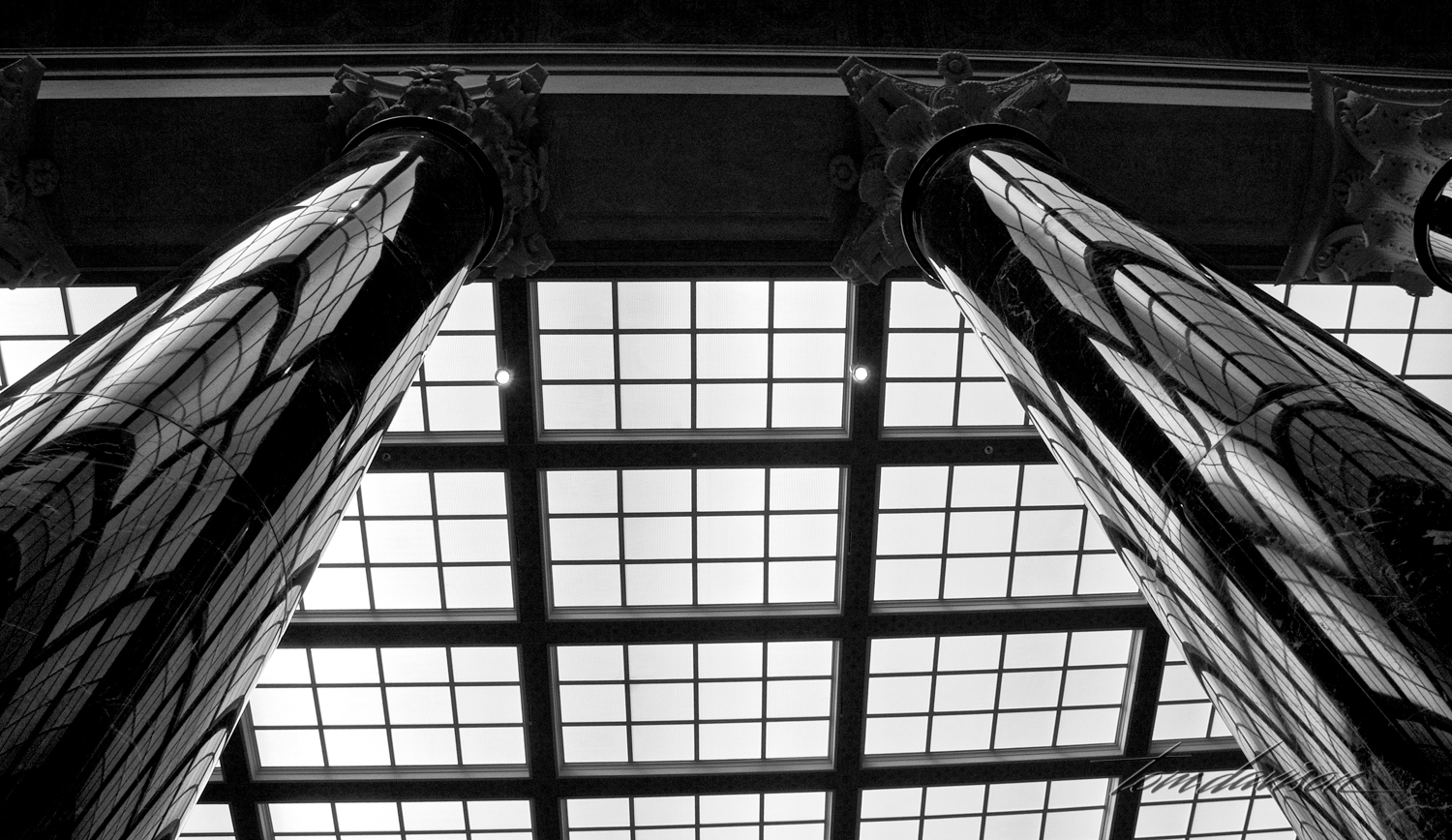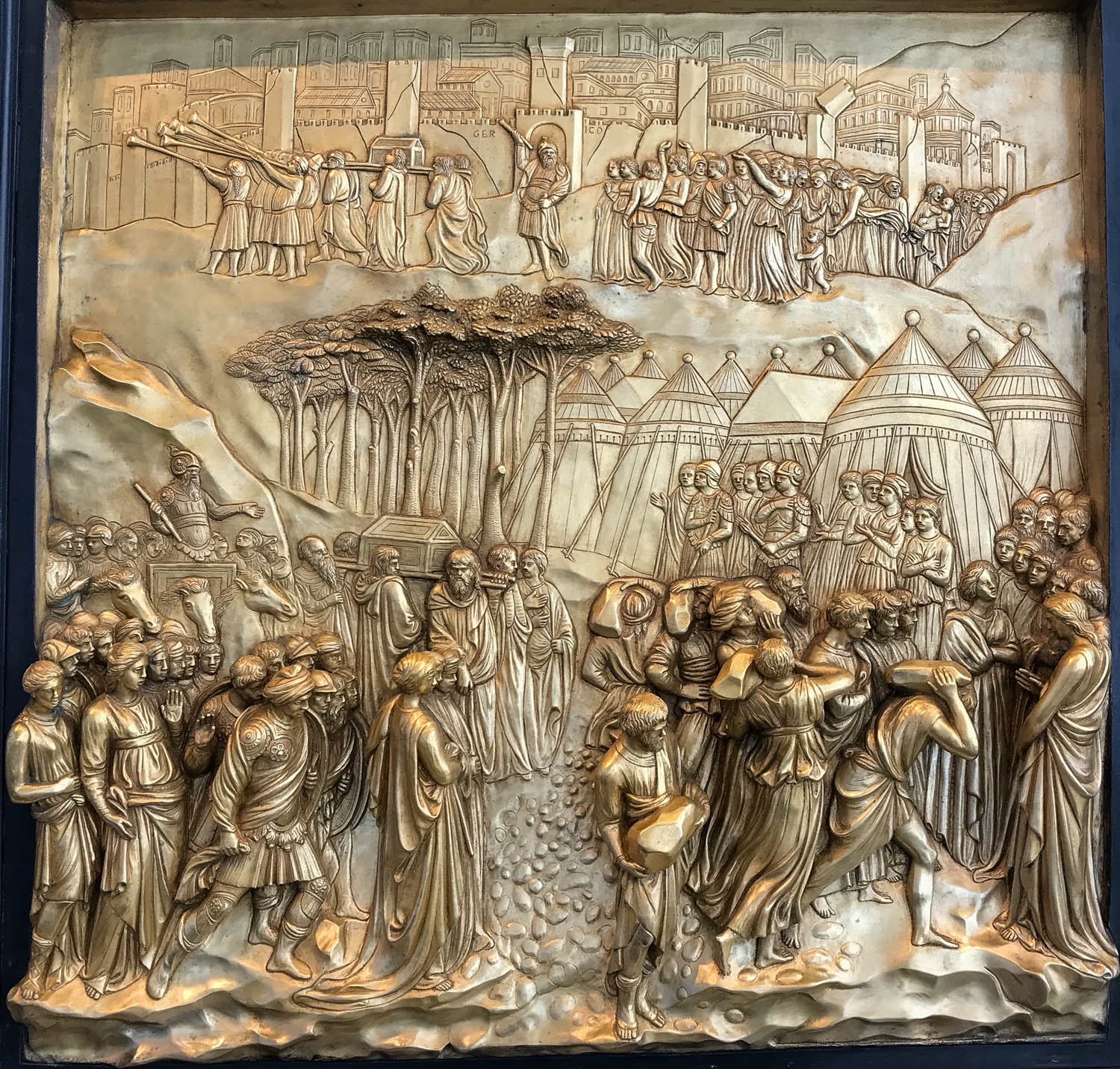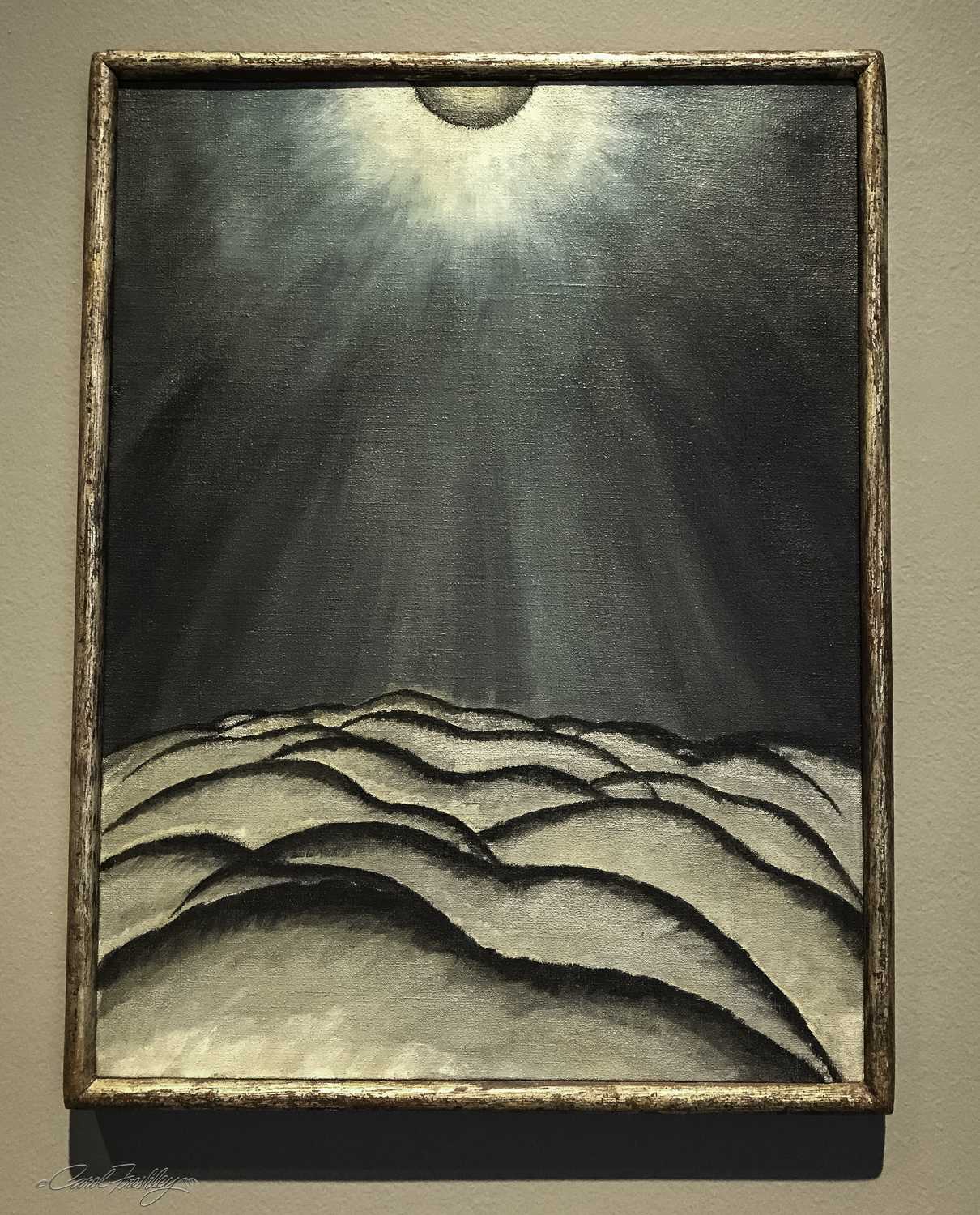This is the last installment covering the day we spent at the Nelson-Atkins Museum. There are many wonderful things about Kansas City and this place is at the top of my list. This blog entry gives you just a taste of some parts of the museum. We did not get to cover many areas. That is OK as we plan on returning to KC and surely will fit this into our schedule.
The interior of the museum is spacious, elegant, resplendent and yet comfortable.
Cafeteria food set at a very high standard for taste and healthfulness set in an awesome indoor patio was inexpensive and a great way to rest our weary feet.
Dusasa I, 2007 by El Anatsui (1944-) Found aluminum and copper wire. This very large wall hanging was one of the first art pieces that we saw after entering the Museum. "Dusasa I was created from recycled liquor-bottle tops that have been flattened and stitched together using copper wire. Working with the metal shapes, El Anatsui allows the material and colors to suggest the composition. The artist's use of liquor-bottle tops acknowledges the historical role of liquor as a commodity traded by colonial powers for slaves and its ritual use as a libation, when it is poured as a form of prayer. . . The title Dusasa comes from Ewe words (people of Ghana), da and sass, meaning a fusion of disparate elements on a monumental scale.!
At the end of a long walkway one will see a huge panel entitled, Gates of Paradise. "They are famous because they mark major advances in rendering perspective, or receding space, and the human figure.
One of the panels from the Gates of Paradise.
Elberta, 1975, by Helen Frankenthaler (1928-2011), Acrylic on canvas. "To create Elberta, Helen Frankenthaler diluted paint to the consistency of watercolor and poured it directly onto raw canvas laid on the floor. The result is a composition of sweeping planes of warm yellow, radiant orange and a contrasting highlight of vivid blue. The narrow band running horizontally along the lower edge of the work is evocative of a horizon line. This horizon-like band and the expansiveness of the composition give this lyrical painting the sense of an abstracted landscape. Elberta's forms and luminous hues make it a quintessential Color Field painting."
Chance Meeting, 1989 by George Segal (1924-2000, Plaster, aluminum and galvanized steel. "Chance Meeting" represents one of George Segal's favorite motifs: people on city streets. . . This pose, along with the title, implies that they are friends or acquaintances who have unexpectedly met on the street. Segal often used family and friends as models. In Chance Meeting, the woman wearing the high heels is the artist's daughter, Rena Segal. This plaster sculpture, part Pop Art and part Realism, contains details captured by the casting process, including folds in the clothing and even top stitching on seams."
Makerchair Jigsaw, prototype, 2014 by Joris Laarman (1979-), ABS (acrylonitrile butadiene styrene). "Often 3-D printing is used for prototyping small objects. Here, Dutch designer Joris Laarman has pushed the boundaries by creating a functional chair constructed of printed components. This prototype features 202 black and white jigsaw pieces that fit together to form the back, seat and supports."
The Chariot, 1950 by Alberto Giacometti (1901-1966) painted bronze. "The solitary, emaciated figure in The Chariot, frozen in a precarious stance, is a poignant reminder of the fragility of life. The sculpture is associated with Etruscan and Egyptian chariot motifs as well as with Giacometti's memories of 'a pharmacy wagon being wheeled around the room' in the Bichat Clinic where he was a patient during World War II. Equally significant to The Chariot is he existential philosophy of his friend Jean-Paul Sartre. Existentialism emphasizes the isolation of the individual in an indifferent universe, where existence is defined by an individual's choices."
Atalanta and Meleager with the Calydonian Boar, 1864-1865, Francesco Mosca, called Il Moschino (1525-1578), Carrara marble. "The ancient Roman poet Ovid provided the subject matter for this sculpture. Here, Meleager, prince of Calydon, is moments away from embracing Atalanta, the virgin huntress with whom he has fallen in love. The two have just killed a wild boar that had been unleashed upon the countryside by Diana, goddess of the hunt, for lack of attention paid to her by the kingdom of Calydon. The head of their trophy, the boar, lies between the two lover's feed. The smooth sensuality of the surface of this sculpture is typical of the refined tase of Mosca's Florentine patrons at the time."
Head of Abe Lincoln, the Hoosier Youth, about 1932, Paul Manship (1885-1966), Bronze. "Representations of Abraham Lincoln abounded throughout the Great Depression, elevating the former president as a champion of the common man. The image of him as a hearty youth full of promise was the most popular. This large sculpted portrait by Paul Manship was commissioned for the Lincoln Life Insurance Company in Fort Wayne, Indiana. Responding to the wishes of his clients, Manship portrayed a young Lincoln. The artist imagined his subject at age 21, creating this image using the smooth modeling and simplified forms of Art Deco."
Natural Bridge, Virginia 1835 by Jacob C. Ward (1809-1891) Oil on panel. "Jacob Ward painted the Natural Bridge in Virginia so that viewers gaze at the geological marvel from below. This low vantage point emphasizes the 200-foot height of the bridge. Listed among the natural wonders of the world, the Natural Bridge was first owned by Thomas Jefferson, who received it from King George III in 1774. During the early 19th century, many artists rendered the Natural Bridge because the site ranked with Niagara Falls as one of the new nation's most inspiring landmarks and tourist attractions. Such natural monuments were thought to distinguish America from Europe."
Gloucester Harbor, 1873, by Winslow Homer (1836-1910), oil on canvas. "Winslow Homer is best known for his dark, brooding seascapes of the 1890s. In the 1870s, however, he was distinguished for scenes of children at play that were considered decidedly lacking in sentimentality. This view of three children in a dory in Gloucester Harbor, Massachusetts, not only depicts a delightful summer outing, but also suggests, by the presence of the huge schooners in the background, the boys' possible future livelihood."
A Lazy Fisherman, 1844 by John Gadsby Chapman, (1808-1889, oil on canvas. From the information tag: "A critic in 1844 described this barefoot boy in ragtag clothing as "laziness personified". His complete ease is embodied in his languid pose and heavy lidded eyes and echoed in the fallen basket, lax fishing line and sluggish river. This sentimental view, rendered with creamy, smooth brushwork, developed from John Gadsby Chapman's experience illustrating volumes of romantic verse. His talent for drawing is revealed in the boy's hat, clothing and especially in the out-turned foot. . . . Pleasing scenes of children were especially popular in the mid-19th century as they offered musings on childhood innocence and freedom in an increasingly challenging world."
Two-Tiered Still Life with Fruit and Sunset Landscape 1867, Severin Roesen (1815-1872), oil on canvas. From the information tag: "Severin Roesen's bountiful still life celebrates and reinforces the popular 19th century notion that America's natural resources distinguished the nation from the rest of the world. In majestic proportions and a vivid palette, an abundant variety of fruit sits atop a two-tiered marble shelf. The dense forest at left and the mountain landscape at right suggest the diversity and power of the American landscape. Painted around the time of the Civil War, the canvas' dramatic and somewhat threatening sky may suggest the question of whether or not America's unique democracy would prevail."
Water Lilies, 1915-1926 by Claude Monet (1840-1926) oil on canvas. From the informational tag: "In 1893, Claude Monet bought land adjacent to his property in Giverny, dug a pond and turned it into a Japanese-inspired water garden. This contemplative environment served as inspiration for a series of paintings that occupied Monet's artistic productions from 1901 until his death in 1926. Typical of his other paintings dedicated to the water lily pond, the subject here is not so much tho flowers but the dream-like effects produced by light reflecting off this liquid world."
Mill at Limetz, 1888 by Claude Monet (1840-1926, oil on canvas. In his later life, Monet gradually became more interested in capturing the effects of light on water, including rivers, the ocean and his famous water lily pond. This is an excellent example of that later period, a dense application of paint woven int a tapestry of luminous color.
The Sonata, 1893 by the American Childe Hassam (1859-1935), oil on canvas. From the tag: "Combining luminous color, staccato brushwork and academic drawing, Childe Hassam's The Sonata exalts sensory and aesthetic experiences. The painting feature a pianist having just performed Beethoven's famously difficult Sonata Appassionata, a score for which she holds in her lap. He slouched posture, echoed by a similarly beautiful but fragile looking yellow rose atop the piano. A Japanese scroll showing a blossoming cherry tree also evokes the dual pleasures of sight and smell." The piece demonstrates the artist's endorsement of a late-19th century movement that proclaimed that art was not obliged to tell a story or to impart morals. Instead, art could be viewed as uplifting society by celebrating beauty.
Man with a Pipe, 1890-1892 by Paul Cézanne (1839-1906), oil on canvas. The artist wrote' "I love above all else the appearance of people who have grown old without breaking with old customs." This painting is one of a group of studies related to The Card Players, one of Cézanne's most important pictorial projects. The local workers reminded him of qualities he admired - steadfast, unchanging, and monumental.











































































